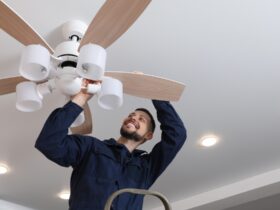Exterior maintenance doesn’t always get the same attention as indoor updates, but it plays a big role in protecting your home. Keeping the outside of your house in good shape helps avoid bigger repairs later. It also adds to curb appeal and keeps everything working the way it should.
In Grand Haven, Michigan, the mix of lake-effect snow, coastal winds, and seasonal changes puts extra pressure on roofing, siding, and outdoor structures. Homes near the water deal with higher moisture levels, which can wear down surfaces faster. That’s why regular checks and small fixes make a big difference here.
Start With the Roof and Gutters
Your roof protects everything underneath it. In Grand Haven, the roof takes on heavy snow in the winter and wind-driven rain in the spring and fall. These conditions can wear down shingles, loosen flashing, and push debris into your gutters. Over time, small problems can grow and lead to water damage or leaks inside your home.
Inspect your roof at least twice a year—once in the spring and again in the fall. Look for missing shingles, soft spots, or any signs of sagging. Check that flashing is still secure around chimneys and vents. If you see dark patches or moss, those could point to trapped moisture or aging materials.
Gutters should stay clear to move water away from your foundation. If they’re full of leaves or clogged with debris, water can spill over and cause problems below. Cleaning them out regularly helps reduce that risk.
If you notice signs of damage after a storm or see water pooling near the roofline, it may be time to contact a trusted Grand Haven roofer to assess and fix the issue before it spreads. Local experts understand the specific challenges of the area and can spot trouble others might miss.
Inspect Siding and Exterior Walls
Siding acts as a shield for your home’s structure. It blocks out wind, moisture, and pests. But like any material, it wears down over time. Cold winters, wet springs, and humid summers can all take a toll on siding surfaces.
Start by walking around your home and checking for obvious signs of damage. Look for cracks, loose panels, bulging areas, or discoloration. These signs may indicate moisture getting trapped behind the siding or materials that are starting to rot. Mold or mildew on the surface may also suggest water is settling where it shouldn’t.
Keep an eye out for any spots where animals or insects might be burrowing in. Small entry points can lead to bigger issues if they’re not addressed.
Simple maintenance like power washing in the warmer months and repainting or sealing every few years can help extend the life of your siding and keep your home looking clean.
Check Windows, Doors, and Seals
Windows and doors help with temperature control and keep water out. Over time, their seals can wear down, causing drafts or leaks. In places where seasonal shifts are common, this kind of wear happens faster.
Start by feeling around your windows and doors for drafts. If you notice cool air in the winter or heat in the summer, it might be time to replace weatherstripping or add caulk around the edges. Look for signs of water staining or soft wood around the frames, too. That could mean water is seeping in.
Broken latches, stuck windows, or foggy glass panels are also signs that something needs attention. These might seem minor, but they can lead to bigger problems like mold or wood rot.
Simple fixes like re-caulking, tightening hardware, or replacing worn seals can make a big difference. They help your home stay comfortable and reduce heating and cooling costs throughout the year.
Monitor Your Foundation and Drainage
The base of your home supports everything above it. If water collects around the foundation, it can cause cracks or erosion. Spring rains and melting snow, in particular, can create perfect conditions for drainage problems if your system isn’t working well.
Walk around your home after heavy rain. Do you see water pooling near the walls or running back toward the house? If so, your grading might need adjustment. Soil should slope away from your home to direct water out and down.
Check that your downspouts are extended at least a few feet from the base of the house. If they’re short or broken, add extensions to carry water farther out. Look for cracks in the foundation itself. Small hairline cracks are common, but anything wider could point to shifting or settling that needs expert attention.
Keeping water away from the home reduces long-term risks. A dry foundation is less likely to develop mold, structural issues, or pest problems.
Keep Outdoor Structures Safe and Clean
Decks, fences, porches, and walkways need care like any other part of the house. Because they’re exposed year-round, these features can wear out faster than people expect.
Check wooden decks for soft spots, loose boards, or rusted nails. Fences may shift after the ground freezes and thaws. Make sure all supports are stable and upright. On porches, look under steps and corners for signs of wood rot or cracked cement.
Clean these areas regularly. Leaves, dirt, and moisture can speed up decay. In the spring or early summer, power wash and reseal wood if needed. Painted surfaces may need touch-ups every few years.
These small tasks help keep your outdoor spaces safe for everyday use and extend their lifespan.
Maintain Landscaping With the House in Mind
Your landscaping should complement your home, not harm it. Bushes and trees that grow too close can damage siding, roofs, and foundations. Roots can shift cement, while overhanging branches can trap moisture or drop debris into gutters.
Trim back any growth that touches the house. Keep mulch and soil away from siding to prevent water buildup or pest nesting. If you notice ant trails, wasp nests, or other pests near your home’s base, act quickly to remove them.
Regular trimming and spacing between plants and your home improves air flow and keeps your structure dry and clean. To maintain a well-balanced and safe landscape design, consider professional soft scaping services that focus on plant placement, ground cover, and aesthetics without compromising your home’s integrity.
Caring for your home’s exterior takes time, but it’s worth it. Keeping up with roof checks, siding repairs, window seals, and drainage helps protect your home from damage and saves money down the line. In places where weather plays a big role, regular maintenance is part of smart homeownership. A little attention each season goes a long way toward keeping your home solid, safe, and looking its best.







Leave a Reply